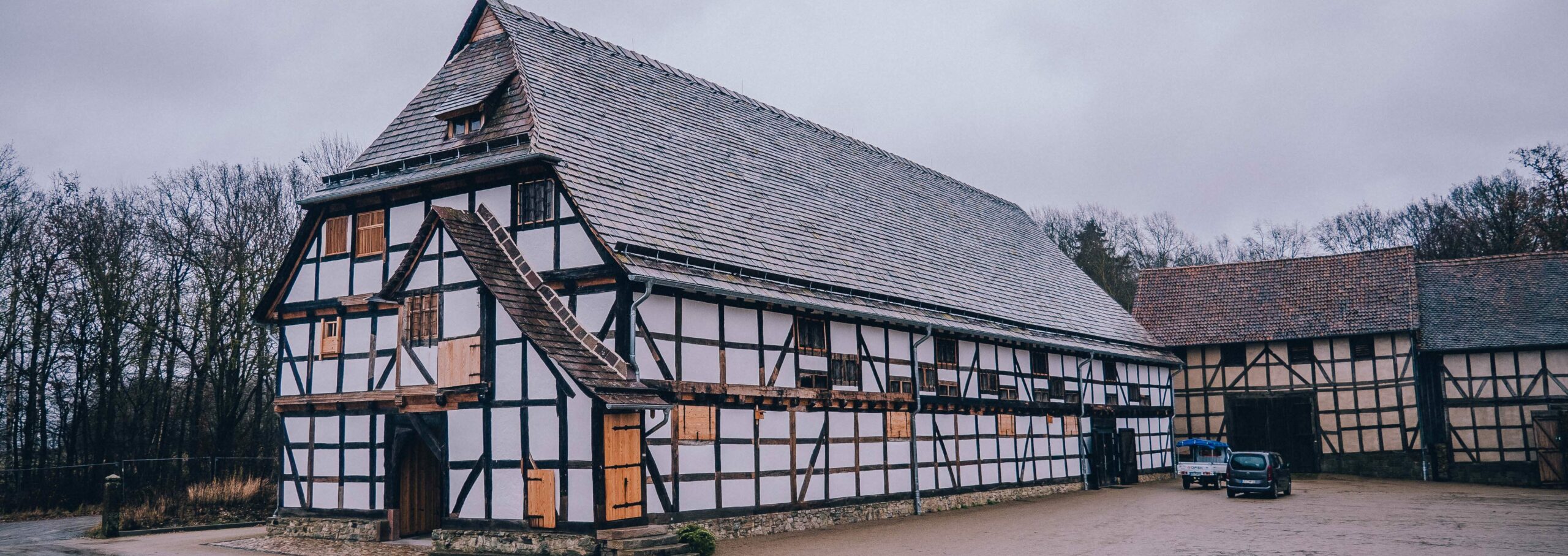Storehouse from Trendelburg

Built: circa 1570
Dismantled: 1975
Reassembled: 1975 to 1978
The building comes from the domain of Trendelburg, a lordly farmstead on the castle barbican. It was most likely first mentioned in a 1568 urbarium, a register of fief ownership, as a new fruit store with a sheep pen on the ground floor, and it served to store produce from the landgrave’s estate. Dendrochronological examinations have resulted in dates from 1569 to 1571. The building, 40 metres long and 14 metres high, was originally built immediately along the outside wall of the domain in the shape of a Diemelland longhouse. It features a gable gate and a large central hall on the ground floor, and a first storage space on the upper floor, which is supported by enormous upward brace posts, as well as two further storerooms under the rafters. The posts which support the roof’s ridge pass through all three storeys.
The farmstead was encircled by a wall and moat and comprised more than ten buildings even back then. In the 16th century, it was one of the largest domains in Hesse, with the state running the domains to maintain its finances. The domain was headed by a bailiff (organisation) and a clerk (financial administration) of the landgrave. The first-floor storeroom held the duties in kind of the surrounding villages, the second the takings of the clerk and the employees, and the third the grain of the landgrave’s miller, whose horses were stabled on the ground floor. From the end of the Thirty Years’ War (1648) until the dissolution of the Prussian Domain Administration Office in 1930, the domain was let on a lease. The contracts included a list of buildings and inventories, and the storage space remained in the possession of the clerk. This may have made the outside stairway necessary. After farmers began to be freed from having to submit their duties in kind, that is, after the tithe, statute labour and privileges were gradually lifted from 1832 onwards, tithe duties were no longer collected from the district’s villages and the storage spaces were leased out individually. After about 1850 they were left to the tenant who used them for his own produce in the last years. When the state’s privileges were abolished, farmers were able to consolidate their arable lands. Since the domain lands, more than 300 hectares in total, were widely dispersed, rearing sheep became progressively less profitable. Sheep had been at the centre of the domain’s animal husbandry activities for centuries, with more than 1,400 sheep and lambs and its own shepherd as well as pens inside and outside the walls in 1568 already. The imposing state-owned building, over 400 years old at that point, was listed in 1955, and finally sold as a storehouse in 1958 to an agricultural seed merchant, with conditions in the contract that ensured the preservation of the building. Fifteen years later it was disassembled, something the state conservation officer only agreed to provided that it would be reassembled in the Hessenpark Open Air Museum. It is therefore the domain’s last storage building still owned by the state, and as such a witness of centuries of Hesse’s economic and financial history.
Following extensive renovation between 2017 and 2020, the building has been accessible again since 2021. The granary from Trendelburg is now shown in its pre-1931 state. Inappropriate modifications that were made during its reconstruction in the museum have now been dismantled. The ground floor now shines in new splendor thanks to the whitewashed beams. It is still available as a venue for events such as weddings, private parties, seminars and congresses. The upper floor is now home to an exhibition on the building’s history and special features.

Mit dem Laden der Karte akzeptieren Sie die Datenschutzerklärung von Google.
Mehr erfahren




